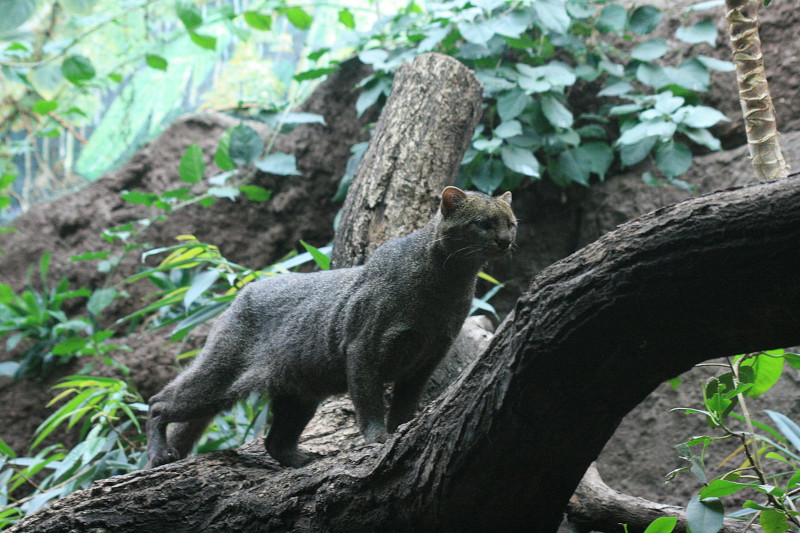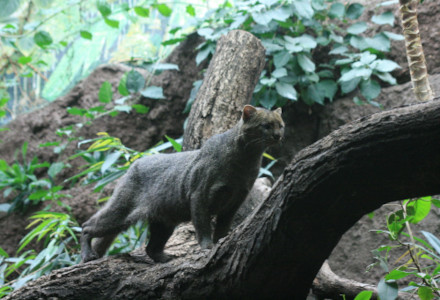
Photographer: UrLunkwill
CC License: https://bit.ly/3lMRpCg
Jaguarundi Facts
- The simple term of Jaguarundi actually serves as the attention-grabbing common name for a truly remarkable species of wild cat. The scientific name of the mammal, however, remains that of the difficult to pronounce Herpailurus yagouaroundi.
- By either name, it represents an animal that, sadly, now only shows scattered population groupings. Thus, it remains vulnerable for several reasons. Officials generally fear that these pockets of habitation, unfortunately, seem to be dying out.
- As a result, the Jaguarundi now represents a protected species throughout the majority of its native range. But, hunting does not pose its greatest threat. Loss of much of its traditional habitat serves as the principal threat to the existence of this mammal.
- In addition, the Amazon Basin currently forms the only region of its range in which the numbers of the awesome Jaguarundi appear to be stable. Despite its somewhat uncertain situation, however, the IUCN currently lists the mammal as Least Concern.
- This surprising status appears on the organization’s Red List of Threatened Species. Nonetheless, many people currently believe it to be threatened. Most likely, at the present time, its greatest threats come from habitat loss and climate change.
Related Articles
Caracal Scottish Wildcat Marbled Cat
Jaguarundi Physical Description
Rather impressively, mature adult specimens of the Jaguarundi averages roughly 30 in (77 cm) in body length. The tail of the feline also reaches a relatively great length of about 24 in (60 cm) in length. Mature adults sometimes weigh as much as 20 lb (9.1 kg).
This amazing species displays no noticeable degree of the physiological trait of sexual dimorphism. This extends to both appearance and physical size. Yet the wild feline does display one unique trait. This holds true due to the fact that it has a unique coloring.
That’s because the fur of different individuals sometimes appears as either a dark chestnut or brownish-black in color. But, quite surprisingly, there seems to be no genetic tendency for this, since individuals of either or both patterns may be born in the same litter.
The amazing Jaguarundi remains known among those who appreciate the wild cats for yet another physical trait. That’s due to its distinctively short legs. In sharp contrast to this characteristic, the body of the remarkable mammal develops as quite elongated.
- Kingdom: Animalia
- Phylum: Chordata
- Class: Mammalia
- Order: Carnivora
- Family: Felidae
- Genus: Herpailurus
- Species: H. yagouaroundi
Jaguarundi Distribution, Habitat, and Ecology
To the surprise of some people, the amazing Jaguarundi represents a small species of wildcat primarily endemic to a moderately broad section of the world. More precisely, this mainly consists of specific regions of South America and Central America.
Scattered small populations of this animal nevertheless also exist as far north as the states of Texas and Florida, in North America. Wherever individuals appear, however, this incredible wild feline exhibits very specific requirements for its choice of habitat.
This holds true since most individuals prefer to inhabit low-lying areas of the brush. But, these must also be in close proximity to streams or small rivers. Although this limits its areas of habitation, it does include habitats ranging from wet grasslands to dry forests.
Human encroachment forced the Jaguarundi to adapt, however. Some also live in dense tropical regions, and at altitudes as high as 10,500 ft (3,200 m). Despite the intense activity, some have even been spotted in the vicinity of the Guiana Space Center, in French Guiana.
Species Sharing Its Range
Oilbird Florida Panther Tiger Flower
Check out our other articles on 6 Incredible Asian Islands, White Spotted Puffer, American Crocodile, Christmas Heliconia, Jewel Wasp, Northern Bald Ibis

